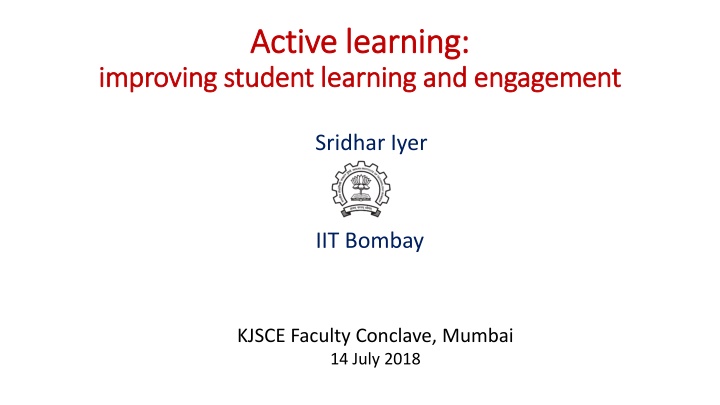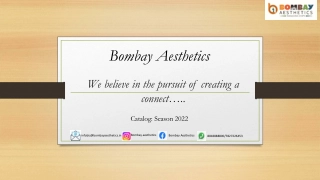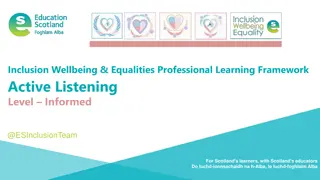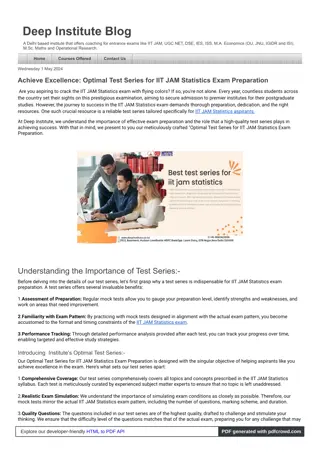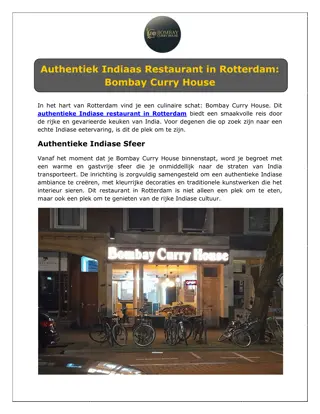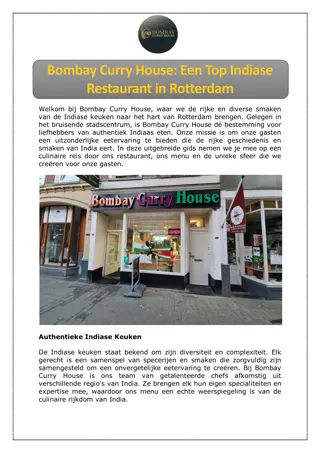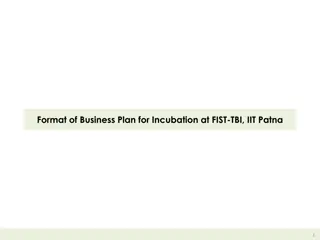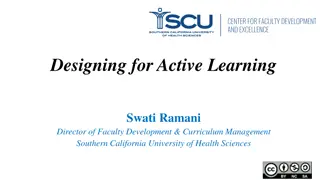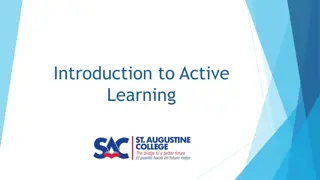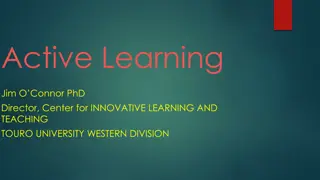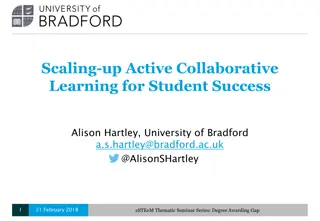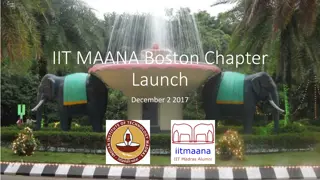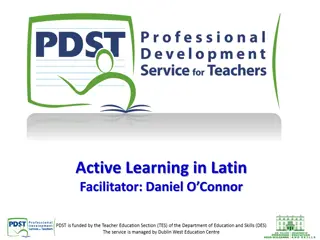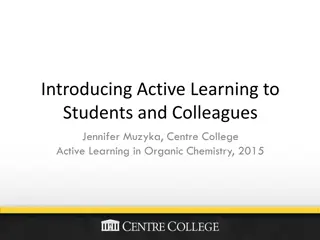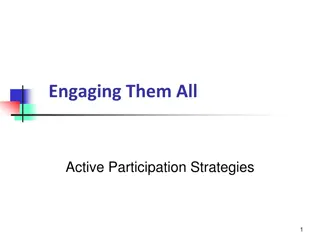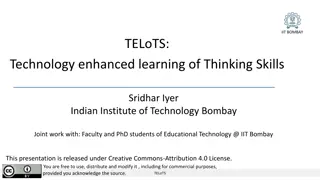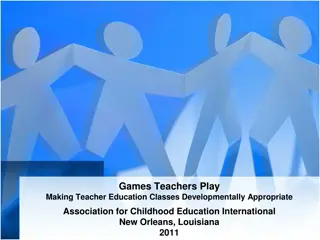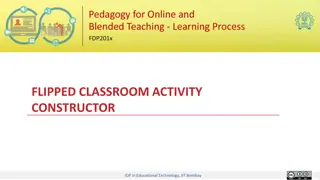Enhancing Student Learning Through Active Learning Strategies at IIT Bombay
Explore how IIT Bombay focuses on improving student engagement and learning through active learning methods and educational technology, including peer discussion technology and Moodle LMS. The interdisciplinary program aims to enhance teaching-learning strategies for better student outcomes and offers insights into the use of technology in education.
Download Presentation

Please find below an Image/Link to download the presentation.
The content on the website is provided AS IS for your information and personal use only. It may not be sold, licensed, or shared on other websites without obtaining consent from the author.If you encounter any issues during the download, it is possible that the publisher has removed the file from their server.
You are allowed to download the files provided on this website for personal or commercial use, subject to the condition that they are used lawfully. All files are the property of their respective owners.
The content on the website is provided AS IS for your information and personal use only. It may not be sold, licensed, or shared on other websites without obtaining consent from the author.
E N D
Presentation Transcript
Active learning: Active learning: improving student learning and engagement improving student learning and engagement Sridhar Iyer IIT Bombay KJSCE Faculty Conclave, Mumbai 14 July 2018
IIT BOMBAY 2 IDP in Educational Technology IIT Bombay | Active Learning
Educational Technology, IIT Bombay IIT BOMBAY Inter-Disciplinary Program, started 2010 - Core faculty, and from departments of CS, engg., science, design, H&SS - 25 PhD research Scholars R&D Focus: - TELoTS: Technology enhanced learning of pan-domain thinking skills - TUET: Teacher use of educational technologies Outreach, training, CEP f2f, Large-scale (5000+) Blended programs, MOOCs 3 Educational Technology, IIT Bombay | Active Learning
What is Educational Technology? IIT BOMBAY Technology of Education Creation and use of Teaching-Learning strategies for student learning and engagement Use of Peer Discussion Technology for Education Creation and use of technologies for various aspects of teaching-learning process Use of MOODLE as LMS Creating a Learning Dashboard Focus is on What to do with/without technology Focus is on Technology 4 Educational Technology, IIT Bombay | Active Learning
What is Educational Technology? IIT BOMBAY Technology of Education Creation and use of Teaching-Learning strategies for student learning and engagement Use of Peer Discussion Technology for Education Creation and use of technologies for various aspects of teaching-learning process Use of MOODLE as LMS Creating a Learning Dashboard Focus is on What to do with/without technology Focus is on Technology 5 Educational Technology, IIT Bombay | Active Learning
Reflection Spot: Think and Write IIT BOMBAY Think of one activity that you excel at doing. [~ 1 min] (Note: Activity could be academics or your hobby) 6 Educational Technology, IIT Bombay | Active Learning
Reflection Spot: Think and Write IIT BOMBAY Think of one activity that you excel at doing. [~ 1 min] (Note: Activity could be academics or your hobby) Think about why you are so good at this activity [~2 min] Write down top 3 reasons for your mastery in this activity 7 Educational Technology, IIT Bombay | Active Learning
Discussion - Excellence IIT BOMBAY Think of one activity that you feel you excel at doing. Think about why you are so good at this activity top 3 reasons Let me guess - One of your top 3 reasons is likely to be: Practice or Experience 8
Discussion - Excellence IIT BOMBAY Again, think of the activity that you feel you excel at doing. Do you feel that you could have gained such mastery by listening to lectures on the topic? Point to keep in mind: As learners, we develop mastery through practice (doing activities, rather than simply listening to lectures, or watching demos). So, As teachers, we must ensure that we provide our students with practice sufficient and timely opportunities. 9
Activity: Think-Pair-Share IIT BOMBAY Scenario 1: An engineering college classroom in 20th Century Scenario 2: An engineering college classroom in 21st Century 10 Educational Technology, IIT Bombay | Active Learning
Activity: Think-Pair-Share IIT BOMBAY Scenario 1: An engineering college classroom in 20th Century Scenario 2: An engineering college classroom in 21st Century Think Write one key difference between two scenarios [Time: ~ 1 min] 11 Educational Technology, IIT Bombay | Active Learning
Activity: Think-Pair-Share IIT BOMBAY Scenario 1: An engineering college classroom in 20th Century Scenario 2: An engineering college classroom in 21st Century Think Write one key difference between two scenarios [Time: ~ 1 min] Pair Discuss with your neighbour and together come up with One difference w.r.t access to information that students have One difference w.r.t role of teachers [Time: ~2 min] 1. 2. 12 Educational Technology, IIT Bombay | Active Learning
Activity: Think-Pair-Share IIT BOMBAY Scenario 1: An engineering college classroom in 20th Century Scenario 2: An engineering college classroom in 21st Century SHARE Student Access of Information - Participant Response Role of teachers - Participant Response 13 Educational Technology, IIT Bombay | Active Learning
20th Century vs 21st Century Classrooms IIT BOMBAY In 20th Century Information was at a premium No Internet, expensive books, limited access to libraries. So, students were mostly listeners and note-takers, absorbing information during the lecture, and doing their practice later. Value for the people who had information, i.e. Teachers 14 Educational Technology, IIT Bombay | Active Learning
20th Century vs 21st Century Classrooms IIT BOMBAY In 20th Century Information was at a premium No Internet, expensive books, limited access to libraries. In 21st Century Information is no longer at premium with internet lot of accessible materials, devices etc. Value for the people who could transmit information, i.e. Teachers Hence, it is not enough for teacher to only transmit information It is necessary for a teacher to ensure that students are able to assimilate the information, through appropriate practice, during the class itself. So, students were mostly listeners and note-takers, absorbing information during the lecture, and doing their practice later. 15 Educational Technology, IIT Bombay | Active Learning
20th Century vs 21st Century Classrooms IIT BOMBAY In 20th Century Information was at a premium No Internet, expensive books, limited access to libraries. In 21st Century Information is no longer at premium with internet lot of accessible materials, devices etc. STUDENT-CENTRIC Value for the people who could transmit information, i.e. Teachers TEACHER-CENTRIC Hence, it is not enough for teacher to only transmit information It is necessary for a teacher to ensure that students are able to assimilate the information, through appropriate practice, during the class itself. So, students were mostly listeners and note-takers, absorbing information during the lecture, and doing their practice later. 16 Educational Technology, IIT Bombay | Active Learning
How to do learner-centric pedagogy IIT BOMBAY One way Active learning techniques. Students go beyond listening, writing notes, executing prescribed procedures. Students asked to figure things out during class. Needs attitude shift of teacher: from content-oriented to learning-oriented. from How well am I lecturing? to How well are they learning? 17 Educational Technology, IIT Bombay | Active Learning
My lectures are plenty interactive! IIT BOMBAY I often pause to ask students if they understood the material. I allow students to interrupt whenever they have doubts. I never hesitate to answer their questions. I show them demos and videos. . VOTE Are students doing active learning if teacher does above? 1) Yes 2) No 18 Educational Technology, IIT Bombay | Active Learning
Why interactive lectures may not be enough IIT BOMBAY Students don t pay utmost attention throughout the lecture. Students think that they understand because they can follow the lecture. - They are not confronted with their misconceptions immediately. Difficult to ensure that all students in the class participate actively. Students with high motivation / achievement levels drive the pace. Students with low achievement levels get left behind. - - Students may have a barrier to responding directly to the instructor. - Shy students don t ask questions, or give answer, even if they have one. - Forcing all students to respond tends to be counter-productive. 19 Educational Technology, IIT Bombay | Active Learning
Evidence for active learning Evidence for active learning 1 1 Comparative study of 62 Physics courses (1998) Trad lecture (14) Active learning strategies (48) Normalized gain <g> = post-pre 100-pre 6542 students Variety of institutions: high school, college, university Test of conceptual reasoning Force Concept Inventory Pre-post, semester long RESULTS: Maximum gain from lecture courses was 0.28 - Many instructors had high scores on teaching evaluations Gain from active-learning courses had a wide range: 0.23-0.7 - AL courses had gains 2-3 times greater than lectures IMPLICATION Desirable to explicitly incorporate active learning strategies in our teaching-learning. R. Hake, Interactive-engagement versus traditional methods: A six-thousand student survey of mechanics test data for introductory physics courses Am. J. Phys., 66 (1998) IIT Bombay 20
Evidence for active learning Evidence for active learning 2 2 Proc. Natl. Acad. Sc, 111(23), 2014 Meta-analysis of 225 studies (2014) Exam performance: higher by 0.47 standard deviations in active learning courses ~ 1/2 letter grade average increase. Failure rates : 33.8% in traditional classes vs 21.8% in active learning courses Results hold across STEM disciplines, majors and non-majors, lower- and upper- division courses. Effect sizes greater for concept inventories than for instructor-written exams. IIT Bombay 21
So, what are active learning strategies? So, what are active learning strategies? Requirements: Students go beyond listening, copying of notes, execution of prescribed procedures. Instructor designs activities that require students to talk, write, reflect and express their thinking. Explicitly based on theories of learning. Evaluated repeatedly through empirical research. Let us see an example D. E. Meltzer and R. K. Thornton. "Resource letter ALIP 1: active-learning instruction in physics." Am. J. Phys, 80.6 (2012): 478-496 IIT Bombay 22
Vote individually Vote individually A large piece of ice is floating in water in a bucket. When it melts what will happen to the water level in the bucket? 1. It will rise. 2. It will fall. 3. It will stay the same IIT Bombay 23
Discuss with your neighbour and Discuss with your neighbour and converge converge A large piece of ice is floating in water in a bucket. When it melts what will happen to the water level in the bucket? 1. It will rise. 2. It will fall. 3. It will stay the same IIT Bombay 24
Have you converged? Then revote. Have you converged? Then revote. A large piece of ice is floating in water in a bucket. When it melts what will happen to the water level in the bucket? 1. It will rise. 2. It will fall. 3. It will stay the same IIT Bombay 25
Peer Instruction (PI) technique Peer Instruction (PI) technique Download the PI-activity-constructor resource sheet from: Download from www.et.iitb.ac.in/TeachingResources.html Ask Question (May vote individually) Lecture Debrief / Class Discussion Peer Discussion Vote Figure attributed to: Stephanie Chasteen and the Science Education Initiative at the University of Colorado IIT Bombay 26
Balloon Video Balloon Video IIT Bombay 27
Using visualizations in class Using visualizations in class Visualizations such as animations and simulations have been shown to provide many learning benefits, especially in STEM disciplines. Many teachers report using such visualizations in their class. Most play or demonstrate the animation in class, along with narrative explanation. IIT Bombay 28
Results from research on use of visualizations Results from research on use of visualizations Showing demo alone is not effective esp for student learning (Hansen et al 2000) Potential benefits of visualization is lost if students merely watch (Lindgren & Schwartz) The way the instructor teaches with the visualization has a profound effect on learning effectiveness (Bratina et.al, 2002) Active-learning instructional strategy with visualization led to improved outcomes than mere viewing (Laasko et al 2009; Windschitl & Andre 1998, Banerjee, Murthy & Iyer 2015) How to incorporate structured active learning strategies? IIT Bombay 29
Example of Visualization Example of Visualization Predict technique Predict technique Predict Phase Check Phase Observe Phase TEACHER: Play viz upto the point the stimulus is shown. PAUSE before result. Don t show rest of viz yet. TEACHER: Ask students to make prediction: What will happen if TEACHER: Shows rest of viz, which has result STUDENTS: Check their prediction by watching the result in viz STUDENTS: Make prediction write, vote, discuss w each other STUDENTS: Observe first part of viz Show rest of movie Will the balloon move? A) Yes, to the left B) Yes, to the right C) No IIT Bombay 30 Link to video: http://paer.rutgers.edu/pt3/experiment.php?topicid=13&exptid=121
Features of active learning strategies Features of active learning strategies Students engage in problem-solving activities during lecture. Students work collaboratively. Students are asked to figure things out for themselves. Ensure (most) students participate Students are asked to express their reasoning explicitly. Qualitative reasoning, conceptual thinking are emphasized. Target misconceptions from think they understand to know whether or not understand Specific student ideas are elicited and addressed. Students receive rapid feedback on their work. IIT Bombay 31
How can an instructor do active learning? How can an instructor do active learning? Some strategies: Peer-Instruction (Eric Mazur, Harvard University, early 1990s) Think-Pair-Share (Frank Lyman, University of Maryland, early 1980s) Many others: (lecture) Team-Pair-Solo, Problem-based learning, Just-in-Time-Teaching, Role-play, Jigsaw, Case-based learning, Peer-review, Productive failure (lab) Pair programming (tutorial) TPS, TPS, PBL, Data-based problem solving IIT Bombay 32
Self Self- -check: check: centric to learner centric strategies Moving from teacher Moving from teacher- -centric to learner centric strategies If your strategy begins with: I will do I will show I will tell Then it is still teacher-centric. To be learner-centric, the strategy should begin with: I will make students do Or better still Students will do IIT Bombay 33
Takeaway Takeaway Make students grapple with content during class. Don t only clarify doubts: Provide frequent opportunities for learners to work with the content Active learning. Ensure immediate and appropriate feedback to learners Peer discussion. Active learning techniques: Peer Instruction: Don t keep MCQs for the exam, make students do them during class. Think-Pair-Share: Don t just lecture, make students do first. Visualizations: Don t just show visualizations, make students predict the outcome. IIT Bombay 34
IIT BOMBAY Thank You www.et.iitb.ac.in 35 Educational Technology, IIT Bombay | Active Learning
